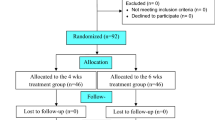Abstract
Benzathine penicillin G (BPG) is effective for secondary prophylaxis of rheumatic fever (RF). However, interval between injections a remains a controversial matter. In a study population of 74 patients, following the initial diagnosis of RF, 3-weekly BPG (1.2 million units) regimen was started. During the first three-week period, serum penicillin concentrations were examined on the 7th, 14th and 21st days and throat culture done for group-A b hemolytic streptococcal (GABHS) infection. Ten patients (13.5%) at 21st day of injection had low serum penicillin concentration after the first BPG. GABHS was isolated in 5 patients during this period. Although two of these 5 patients had symptoms of respiratory tract infection, according to laboratory data, the other three were accepted as carriers. All 74 patients were then followed-up for rheumatic recurrence (RR) during long-term period (6 to 60 months, mean 25 ± 5 months). There was no RR among regular (missing no more than one injection a year) group. We concluded that 3-weekly BPG regimen was satisfactory for secondary prophylaxis in RF, even though serum penicillin level was inadequate during the third week in some of the patients.
Similar content being viewed by others
References
WHO Cardiovascular Disease Unit and principal investigators. WHO programme for the prevention of rheumatic fever/rheumatic heart disease in 16 developing countries: report from phase I (1986–90).WHO Bulletin OMS 1992; 70 : 213–218.
Eisenberg MJ. Rheumatic heart disease in the developing world: prevalence, prevention and control.Eur Heart J 1993; 14 (1): 122–28.
Ferrieri P. Acute rheumatic fever to come-back of a disappearing disease.AJDC 1987; 141: 725–27.
Hosier DM, Craenen JM, Teske DWet al. Resurgence of acute rheumatic fever.AJDC 1987; 141: 30–33.
Congeni B, Rizzo C, Congeni Jet al. Outbreak of acute rheumatic fever in north east Ohio.J Pediatr 1987; 111: 176–79.
Bisno AL. The rise and fall (and rise?) of rheumatic fever.JAMA 1988; 259: 728–29.
Bland EF. Rheumatic fever: the way it was.Circulation 1987; 76 :1190–95.
Bisno AL. Group A streptococcal infections and acute rheumatic fever.N Engl J Med 1991; 325: 783–93.
Dajani AS, Bisno AL, Chung KJet al. Prevention of rheumatic fever. A statement for health professionals by the committee on rheumatic fever, endocarditis, and Kawasaki disease of the Council on Cardiovascular Disease in the Young. The American Heart Association.Circulation 1988; 78: 1082–86.
Lue HC, Wu MH, Wang KJet al. Rheumatic fever recurrences: controlled study of 3-week versus 4-week benzathine penicillin prevention programme.J Pediatr 1986; 108 : 299–304.
Padmavati S, Gupta V, Prakash Ket al. Penicillin for rheumatic fever prophylaxis 3-weekly or 4-weekly schedule?JAPI 1987; 35: 753–755.
Ayoub EA. Prophylaxis in patients with rheumatic fever: every three or every four weeks?J Pediatr 1989; 115 : 89–91.
Kasseem AS, Madkour AA, Massoud BZet al. Benzathine penicillin G for rheumatic fever prophylaxis: 2-weekly versus 4-weekly regimens.Indian J Pediatr. 1992; 59 : 741–48.
Decourt LV, Santos SRCJ, Snitcowsky Ret al. Niveis sericos da penicilina G benzatina apos administraÇao intramuscular.Arq Bras Cardiol 1983; 40: 3–8.
Special Writing Group of the Committee on Rheumatic Fever, Endocarditis, and Kawasaki Disease of the Council on Cardiovascular Disease in the Young of the American Heart Association. Guidelines for the diagnosis of rheumatic fever.JAMA 1992; 268: 2069–73.
Gerber MA, Randolph MF, Mayo DR. The group A streptococcal carrier state.AJDC 1988; 142: 562–65.
Stollerman GH, Lewis AL, Schultz Iet al. Relationship of immune response to group A streptococci to the course of acute chronic and recurrent rheumatic fever.Am J Med 1956; 20:163–69.
Moats WA. Determination of penicillin G, penicillin V and cloxacillin in milk by reversed-phase high performance liquid chromatography.J Agric Food Cham 1983; 31: 880–83.
Briguglio GT, Lau-Cam CA. Separation and identification of nine penicillins by reverse phase liquid chromatography.J Assoc. Off Anal Chem 1984; 67: 228–31.
Meira ZMA, Mota CC, Tonelli E. Evaluation of secondary prophylactic schemes based on benzathine penicillin G for rheumatic fever in children.J Pediatr 1993; 123:156–58.
Karabiber N, Türet S. A grubu beta-hemolitik streptokoklada penisilin tolerasinin gösterilmesinde gradiend-replika plate yönteminin kullanilmasi.ANKEM 1991 5:1–7.
Thamlikitkul V, Kobwanthanakun S, Pruksachatvuthi Set al. Pharmacokinetics of rheumatic fever prophylaxis regimens.J Int Med Res 1992; 20: 20–26.
Grahn E, Holm SE, Roos K. Penicillin tolerance in beta streptococci isolated from patients with tonsillitis.Scand J Infect Dis 1987; 19: 421–26.
Kim KS, Kaplan EL. Association of penicillin tolerance with failure to eradicate group A streptococci from patients with pharyngitis.J Pediatr 1985; 107: 681–84.
Brook I. The role of \-Lactamase producing bacteria in the persistence of streptococcal tonsillar infection.Rev Infect Dis. 1984; 6: 601–607.
Smith TD, Huskins WC, Kim KSet al. Efficacy of beta-lactamase-resistant penicillin and influence of penicillin tolerance in eradicating streptococci from the pharynx after failure of penicillin therapy for group A streptococci pharyngitis.J Pediatr 1987; 110: 777–82.
Gastanaduy AS, Kaplan EL, Huwe BBet al. Failure of penicillin to eradicate group A streptococci during an outbreak of pharyngitis.Lancet 1980; 2: 498–502.
Kliegman RM, Feigin RD. Streptococcal infections. In: Behrman RE (eds).Nelson Textbook of Pediatrics. Philadelphia : W.B. Saunders Company 1992; 698–703.
Author information
Authors and Affiliations
Rights and permissions
About this article
Cite this article
Oran, B., Taştekin, A., Karaaslan, S. et al. Prophylactic efficiency of 3-weekly benzathine penicillin G in rheumatic fever. Indian J Pediatr 67, 163–167 (2000). https://doi.org/10.1007/BF02723652
Issue Date:
DOI: https://doi.org/10.1007/BF02723652




